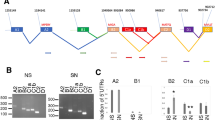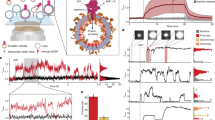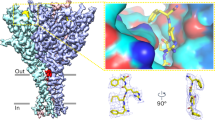Abstract
Selected actions of neurotransmitters and hormones on ion channels in nerve and muscle cells are now thought to be mediated by cyclic AMP-dependent protein phosphorylation1–11. Although the cyclic AMP-dependent protein kinase (cAMP-PK) affects the cellular properties of several neurones, its mode of action at the single-channel level has not been characterized. In addition, little is known about the identity or subcellular localization of the phosphoproteins that control channel activity and, in particular, whether the critical substrate proteins are cytoplasmic or membrane-associated. In Aplysia sensory neurones, serotonin produces a slow modulatory synaptic potential mediated by cAMP-PK12 that contributes to presynaptic facilitation and behavioural sensitization12. Previously, we have found that serotonin acts on cell-attached membrane patches to produce prolonged all-or-none closures of a specific class of K+channels (S channels) whose gating is weakly dependent on voltage and independent of intracellular calcium13–15. We demonstrate here that in cell-free membrane patches from Aplysia sensory neurones, the purified catalytic sub-unit of cAMP-PK16 produces all-or-none closures of the S channel, simulating most (but not all) aspects of the action of serotonin on cell-attached patches. This result suggests that protein kinase acts on the internal surface of the membrane to phosphorylate either the channel itself or a membrane-associated protein that regulates channel activity.
This is a preview of subscription content, access via your institution
Access options
Subscribe to this journal
Receive 51 print issues and online access
$199.00 per year
only $3.90 per issue
Buy this article
- Purchase on Springer Link
- Instant access to full article PDF
Prices may be subject to local taxes which are calculated during checkout
Similar content being viewed by others
References
Castellucci, V. F. et al. Proc. natn. Acad. Sci. U.S.A. 77, 7492–7496 (1980).
Castellucci, V. F., Nairn, A. C., Greengard, P., Schwartz, J. H. & Kandel, E. R. J. Neurosci. 2, 1673–1681 (1982).
Kaczmarek, L. K. et al. Proc. natn. Acad. Sci. U.S.A. 77, 7487–7491 (1980).
Adams, W. B. & Levitan, I. B. Proc. natn. Acad. Sci. U.S.A. 79, 3877–3880 (1982).
De Peyer, J. E., Cachelin, A. B., Levitan, I. B. & Reuter, H. Proc. natn. Acad. Sci. U.S.A. 79, 4207–4211 (1982).
Doroshenko, P. A., Kostyuk, P. G., Martynyuk, A. E., Kursky, M. D. & Vorobetz, Z. D. Neuroscience 11, 263–267 (1983).
Alkon, D. L., Acosta-Urquidi, J., Olds, J., Kuzma, G. & Neary, J. T. Science 219, 303–306 (1983).
Brum, G., Flockerzi, V., Hofman, F., Osterrieder, W. & Trautwein, W. Pflügers Arch. ges. Physiol. 398, 147–154 (1983).
Kennedy, M. A. Rev. Neurosci. 6, 493–525 (1983).
Nestler, E. J. & Greengard, P. Nature 305, 583–588 (1983).
Siegelbaum, S. A. & Tsien, R. W. Trends Neurosci. 6, 307–313 (1983).
Kandel, E. R. & Schwartz, J. H. Science 218, 433–442 (1982).
Siegelbaum, S. A., Camardo, J. S. & Kandel, E. R. Nature 299, 413–417 (1982).
Klein, M., Camardo, J. S. & Kandel, E. R. Proc. natn. Acad. Sci. U.S.A. 79, 5713–5717 (1982).
Camardo, J. S., Shuster, M. J., Siegelbaum, S. A. & Kandel, E. R. Cold Spring Harb. Symp. quant. Biol. 48, 213–220 (1983).
Beavo, J. A., Bechtel, P. J. & Krebs, E. G. Meth. Enzym. 38, 299–308 (1974).
Hamill, O. P., Marty, A., Neher, E., Sakmann, B. & Sigworth, F. J. Pflügers Arch. ges. Physiol. 391, 85–100 (1981).
Adams, D. J., Smith, S. J. & Thompson, S. H. A. Rev. Neurosci. 3, 141–163 (1980).
Meech, R. W. A. Rev. Biophys. Bioengng 7, 1–18 (1978).
Ingebritsen, T. S. & Cohen, P. Science 221, 331–337 (1983).
Saitoh, T. & Schwartz, J. H. Proc. natn. Acad. Sci. U.S.A. 80, 6708–6712 (1983).
Revel, H. R. Meth. Enzym. 6, 211–214 (1963).
Rail, W. T. & Sutherland, E. W. J. biol. Chem. 232, 1065–1076 (1958).
Bernier, L. thesis, Univ. Columbia (1984).
Mailer, J. L., Kemp, B. E. & Krebs, E. G. Proc. natn. Acad. Sci. U.S.A. 75, 248–252 (1978).
Author information
Authors and Affiliations
Rights and permissions
About this article
Cite this article
Shuster, M., Camardo, J., Siegelbaum, S. et al. Cyclic AMP-dependent protein kinase closes the serotonin-sensitive K+channels of Aplysia sensory neurones in cell-free membrane patches. Nature 313, 392–395 (1985). https://doi.org/10.1038/313392a0
Received:
Accepted:
Issue Date:
DOI: https://doi.org/10.1038/313392a0
This article is cited by
-
Mapping Molecular Memory: Navigating the Cellular Pathways of Learning
Cellular and Molecular Neurobiology (2012)
-
State-dependent disruption of short-term facilitation due to overexpression of the apPDE4 supershort form in Aplysia
Molecules and Cells (2011)
-
The neuronal background K2P channels: focus on TREK1
Nature Reviews Neuroscience (2007)
-
The Molecular Biology of Memory Storage: A Dialog Between Genes and Synapses
Bioscience Reports (2004)
-
GABA-receptors: Physicochemical properties, specific features of organ topography (a review)
Pharmaceutical Chemistry Journal (1995)
Comments
By submitting a comment you agree to abide by our Terms and Community Guidelines. If you find something abusive or that does not comply with our terms or guidelines please flag it as inappropriate.



